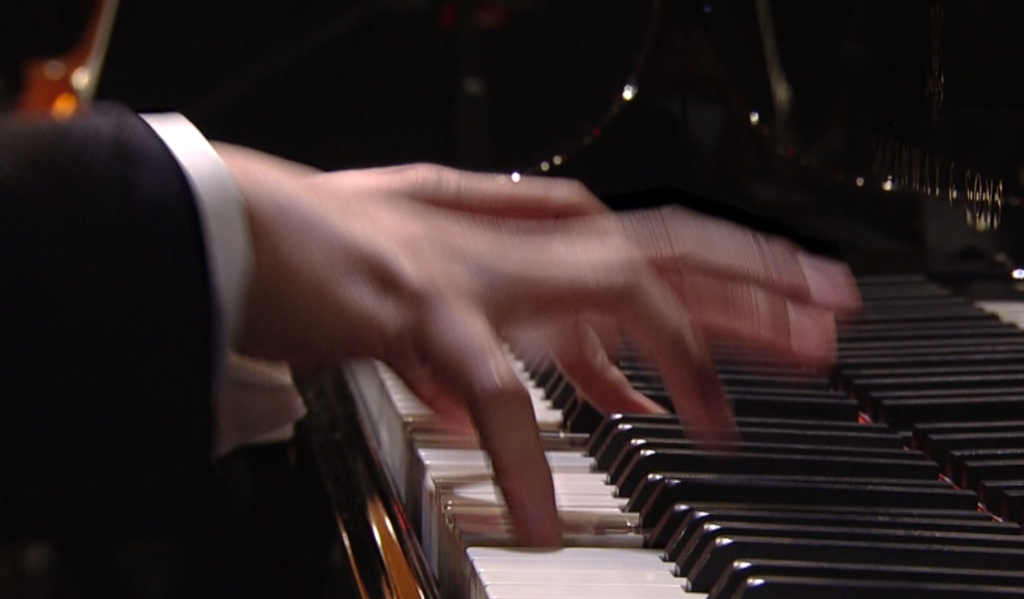
Grand Piano Interface

Grand Piano Interface
The Grand Piano Interface ™ developed by ADiS Music transcends your play by letting you dive into the most subtle corners of the score.
Why Grand Piano Interface ?
The Grand Piano Interface ™ draws its quintessence from two features hitherto unexplored in the digital world of classical music.
The first one, intimately linked to the whole musical content embedded within the ADiS score, allows the rendering as well as the automatic scrolling of each page when you hit the notes on the keyboard.
Whatever your performance speed, the tempo is analysed, automatically recognized and the pages accordingly scroll as if by magic.

A sophisticated algorithm supported by an artificial neural network lets, within a reasonable limit, get rid of eventual wrong notes and show the exact location on the score.
The repeats or jumps of the different passages on the score, such as coda, will have been previously stored in the settings to make a new ADiS score version.
You stay perfectly focused on your rehearsal or performance and your technique without having to carry out any action to scroll the pages or resume a passage.

A sophisticated algorithm supported by an artificial neural network lets, within a reasonable limit, get rid of eventual wrong notes and show the exact location on the score.
The repeats or jumps of the different passages on the score, such as coda, will have been previously stored in the settings to make a new ADiS score version.
You stay perfectly focused on your rehearsal or performance and your technique without having to carry out any action to scroll the pages or resume a passage.
The second feature is enshrined in the tempo recognition previously described and that is shared with the musicians you play with.
Your device, connected to the Grand Piano Interface ™, becomes a kind of pilot spreading out information to the orchestra or the ensemble.
The devices getting that information will be in turn able to scroll the pages of the different parts without any intervention of their performers.
This concept applies to the chamber music ensemble but also to the symphonic orchestra while providing the label registered by ADiS Music “Tutti A Tempo”.
More option to go further
Who never dreamed of transcribing organ works for the piano ?
Who never dreamed of feeling the power of a 16′ Bourdon organ stop ?
Many composers very quickly understood that the piano, even for concert models, met great difficulty in competing with the Liepzig Maestro’s instrument.
Guided through an original idea by the composer Ferrucio Busoni, the piano maker Bösendorfer built in 1909 the first instrument with a full octave down to C O.
The first instrument offering 9 additional low notes was born.
The first instrument offering 9 additional low notes was born.
Henceforth it was possible to render the powerful D at the pedal from the famous toccata BWV 565.
Composers no less famous as Ravel or Debussy wrote for this extended and unrivaled instrument, not to mention Bela Bartok’s sonata BB 88 whose second movement, as shown on the score below, teases these hitherto unexplored notes.


Henceforth it was possible to render the powerful D at the pedal from the famous toccata BWV 565.
Composers no less famous as Ravel or Debussy wrote for this extended and unrivaled instrument, not to mention Bela Bartok’s sonata BB 88 whose second movement, as shown on the score below, teases these hitherto unexplored notes.

Committed to meet the needs of demanding professionals, ADiS Music could only provide the Grand Piano Interface with the optional Bösendorfer.
Quick and easy installation
The installation of the Grand Piano Interface is quick and easy. It is carried out by yourself, without specialist intervention.
The kit includes one interface housing, the various optical sensors boards (four units for the standard version, five units for the Imperial Bösendorfer version), on mounting profile rail as well as the various necessary cables.
One user manual can be downloaded as soon as the order is placed.
Committed to meet the needs of demanding professionals, ADiS Music could only provide the Grand Piano Interface with the optional Bösendorfer.

Quick and easy installation
The installation of the Grand Piano Interface is quick and easy. It is carried out by yourself, without specialist intervention.
The kit includes one interface housing, the various optical sensors boards (four units for the standard version, five units for the Imperial Bösendorfer version), on mounting profile rail as well as the various necessary cables.
One user manual can be downloaded as soon as the order is placed.
A few technical specifications
The standard version of the Grand Piano Interface is built around 88 subminiature optical sensors allowing to detect the tiniest displacement of each key on the instrument.
The total absence of physical contact between the optical sensors and the keys of the keyboard preserves the sound quality of the instrument.
The option Imperial Bösendorfer includes 9 sensors completing the full system with 97 sensors.
The processing of data from the different sensors is provided by a ARM based microcontroller.
The encapsulated information within a proprietary format is sent to the ADiS device.
